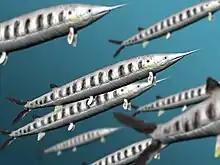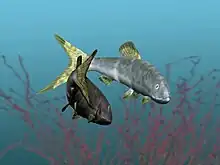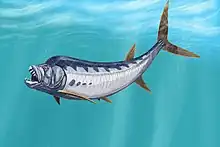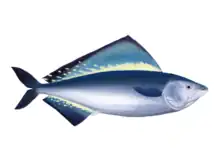| Tselfatia Temporal range: Late Cretaceous, | |
|---|---|
 | |
| T. formosa specimen | |
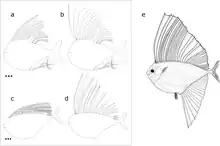 | |
| Reconstruction | |
| Scientific classification | |
| Domain: | Eukaryota |
| Kingdom: | Animalia |
| Phylum: | Chordata |
| Class: | Actinopterygii |
| Order: | †Tselfatiiformes |
| Family: | †Plethodidae |
| Genus: | †Tselfatia Arambourg, 1944 |
| Type species | |
| †Tselfatia formosa Arambourg, 1944 | |
| Other species | |
| |
Tselfatia is an extinct genus of Cretaceous bony fish. Originally described from (and named after) Djebl Tselfat in Morocco, it has since been discovered at sites in several other countries (Texas/USA, Germany, Mexico, Italy and the former Yugoslavia). The type species, Tselfatia formosa, was named and described in 1944 by French paleontologist Camille Arambourg.[1] A second species, T. dalmatica, was named in 1980 from the Dalmatian Coast of Yugoslavia.[2]
The enormous dorsal fin as well as the large anal fin both feature one much enlarged ray, characteristic for the genus. These fish are never common and more work needs to be done on the known specimens.
References
- ↑ "Tselfatia". Global Biodiversity Information Facility. Retrieved 2024-01-05.
- ↑ Bardack, David & Teller-Marshall, Susan (1980). Tselfatia, a Tethyan Cretaceous teleost; first records from North America and Yugoslavia. Journal of Paleontology. 54 (5): 1075–1083.
External links
This article is issued from Wikipedia. The text is licensed under Creative Commons - Attribution - Sharealike. Additional terms may apply for the media files.

